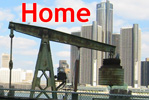

  |
|
last modified: Sunday, December 18, 2005 8:10 PM |
|
Bus Rapid Transit: A Powerful Real Estate Development Tool |
|
William Kaplowitz |
wmkap@umich.edu |
In professional surveys and public debates over mass transit programs it has been claimed that rail transit leads to greater new development clusters than does bus transit. This factor has been used by some to argue for investment in rail rather than buses, despite the substantially greater costs of rail, particularly the capital costs in establishing rail infrastructure. A similar argument was at a public meeting regarding the proposed Ann Arbor – Detroit transit link.
Proponents of such a view theorize that trains attract greater development precisely because of that costlier infrastructure. They argue that the cost and physical permanence of tracks gives entrepreneurs and investors confidence that the transit upon which they are relying to bring in customers, clients, and employees will persist over the long-term and will justify their investment. Bus systems – which are often attractive to transportation planners precisely because their routes are flexible and can be modified or ended altogether at low cost (GAO 2001: 28-30) – lack this element and should therefore be less effective in attracting development (See, e.g., ibid: 31).
Research, however, suggests that tracks are not what differentiate trains from standard bus service with regard to real estate development: stations and other streetscape improvements make the difference. In those areas where Bus Rapid Transit systems feature attractive, substantial, and permanent seeming stations, significant real estate development, comparable to that surrounding rail stations, has occurred. (FTA 2004: 5-6).
What is BRT?
Bus Rapid Transit, or BRT, is a “flexible, high performance rapid transit mode that combines a variety of physical, operating and system elements into a permanently integrated system with a quality image and unique identity” (Levinson et al. 2003: Volume 1, 1-1). This characterization is necessarily convoluted and ambiguous because the term Bus Rapid Transit encompasses so many different systems with different attributes.
Two common features of all BRT systems are that they 1) use buses as the transit vehicles, which allows for greater flexibility and potentially lower costs; and 2) that they attempt to provide a rider-ship experience like that experienced on light rail, heavy rail, or commuter rail by providing such features as aesthetically pleasing vehicles and stations, providing punctual service, and reducing boarding times through such features as low floor buses (Levinson et al. 2003: Volume 2).
Some BRT systems, as in Ottawa, have their own rights-of-way off of public roads, known as busways, whereas others, such as Honolulu’s system, use High Occupancy Vehicle Lanes or special Bus lanes on freeways. Where new rights of way are constructed, capital costs will clearly be higher than where existing surfaces are used. Nonetheless, the costs per mile of BRT systems using exclusive bus-ways – the most expensive type of BRT of system –are substantially lower costs than those for light rail lines (GAO 2001: 19-20).
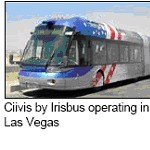 Some BRT systems use sleek, futuristic buses; others use conventional buses.
See Figure 1 (FTA 2004). In both cases, as with separate rights of way versus
travel on public streets, impressive new real estate development still results.
Some BRT systems use sleek, futuristic buses; others use conventional buses.
See Figure 1 (FTA 2004). In both cases, as with separate rights of way versus
travel on public streets, impressive new real estate development still results.
No Tracks? No Problem. BRT Attracts Development with its Infrastructure.
The results of case studies on BRT systems in a variety of systems are clear:
1) BRT attracts new development at the same scale as rail-based transit, even though BRT is less expensive than rail, and even though its capital investments are less permanent.
2) This is because BRT still does require a substantial, although lesser, investment in infrastructure, and this investment suggests permanence (FTA 2004).
3) Most importantly, when BRT stations are attractive and prominent destination and departure points, development will follow.
Attractive vehicles can help encourage development, although they are by no means necessary. Boston’s new Silver Line BRT uses such buses and the two different phases of that project have attracted nearly $600 million worth of new real estate development. On the other hand, Pittsburgh, which uses conventional buses, has also experienced tremendous growth around the Martin Luther King Jr. East Busway -- $225 million in new construction. Significantly, 80% of that construction has been clustered specifically around the system’s stations. As the FTA reports, “development can still occur with all vehicle types as long as service improvements highlight the attractiveness of station locations” (FTA 2004).
BRT Can Run on Dedicated Rights of Way or City Streets: Real Estate Investment Follows.
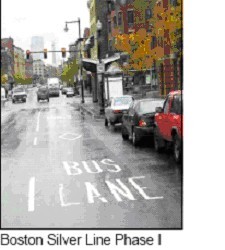 The Boston Silver
Line also illustrates another important point – BRT attracts development
whether it runs on separate rights-of-way or on city streets. Phase
I of the Silver Line was constructed on a public street. See Figure
2 (FTA 2004). The project repaved and re-landscaped the street and
has attracted substantial real estate investment. Phase II of the
Silver Line runs through an underground tunnel. This too has attracted
enormous investment.
The Boston Silver
Line also illustrates another important point – BRT attracts development
whether it runs on separate rights-of-way or on city streets. Phase
I of the Silver Line was constructed on a public street. See Figure
2 (FTA 2004). The project repaved and re-landscaped the street and
has attracted substantial real estate investment. Phase II of the
Silver Line runs through an underground tunnel. This too has attracted
enormous investment.
Orlando’s LYMMO system runs on arterial city streets, using special bus lanes that are separated from other traffic (GAO 2001: 19-20). See Figure 3 (Levinson 2003: Volume 2). Although the special lanes made its infrastructure costs substantially higher than some other BRTs that do not have special lanes, such as Los Angeles’s system, it was still a relative bargain compared to Pittsburgh’s East Busway -- which required construction of a separate road, see Figure 4 (FTA 2004) – and even more of a bargain when compared to light rail lines (GAO 2001: appendices). Since the inauguration of the LYMMO, approximately 5 million square feet of new office development and six new apartment complexes have been built in downtown Orlando (FTA 2004).
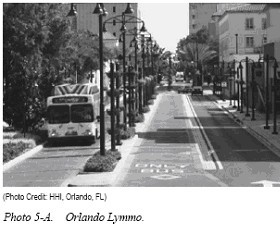
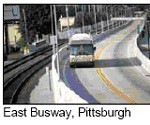 Real estate development
along Cleveland’s Euclid Avenue received a major boost when plans were
unveiled for a BRT line. The presence of “identifiable station structures” was
cited as a key reason for this speculative development (GAO 2001: 31).
Real estate development
along Cleveland’s Euclid Avenue received a major boost when plans were
unveiled for a BRT line. The presence of “identifiable station structures” was
cited as a key reason for this speculative development (GAO 2001: 31).
Stations Create a Permanent Destination
Ultimately, as has been illustrated by cases in Boston, Pittsburgh, Orlando, and Cleveland, the key reason why development follows BRT is not that BRT often runs on expensive infrastructure like busways, or that BRT sometimes uses fancy new buses.
BRT attracts real estate development because BRT stations are substantial enough and classy enough to signal to developers that the stop will become a permanent destination. “Station design has the greatest impact on the economic vitality of an area. A new BRT station provides opportunity to enhance travel and create a livable community at the same time.” (FTA 2004: 4-18).
When BRT systems feature such attractive stations and offer good quality service, they attract new real estate development equivalent to that attracted by rail transit. (See FTA 2004).
Implications for Economic Development Planning
This does not mean that Bus Rapid Transit is equal to rail transit as an economic development tool. Economic development is a broad term that has been defined as “progress towards a community’s economic goals, including increased productivity, employment, business activity, investment and redevelopment” (Litman 2004). For example, the General Accounting Office has noted that there are at least two possible economic development advantages of light rail over BRT. First, light rail allows a city to project an image of itself as a world class city, thereby attracting investment based on the city’s prestige. Second, according to the GAO, light rail, unlike BRT, defines corridors of development, thus spurring – or at least attracting – new development of real estate in those areas. (GAO 2001: 31).
In fact, it may be true that rail transit is, overall, a better economic development tool. Although Bus Rapid Transit is able to overcome some of the image problems suffered by standard bus transit, it is unlikely to ever be fully as prestigious as rail transit. Bus Rapid Transit may also not have the same congestion or pollution reduction effects as rail transit. These are extremely important factors that communities should consider as they decide what form of mass transit is right for them, and that seem to weigh in on the side of rail transit.
Nonetheless, when it comes strictly to the issue of new real estate development, Bus Rapid Transit systems, so long as they feature attractive and significant stations, can be the equal of rail transit. This equality, combined with BRT’s greater flexibility and lesser cost, should encourage communities to carefully consider whether BRT might be right for them.
References
Federal Transit Administration. Characteristics of Bus Rapid Transit for Decision-
Making. August 2004. Available at http://www.fta.dot.gov/documents/CBRT.pdf. Last Accessed November 2, 2005
General Accounting Office. Mass Transit: Bus Rapid Transit Shows Promise.
September 2001. Available at http://www.gao.gov/new.items/d01984.pdf. Last Accessed November 2, 2005.
Levinson, Herbert, Samuel Zimmerman et al (2003). TCRP Report 90: Bus Rapid
Transit Volume 1: Case Studies in Bus Rapid Transit. Available at http://gulliver.trb.org/publications/tcrp/tcrp_rpt_90v1.pdf. Last Accessed November 2, 2005.
Levinson, Herbert, Samuel Zimmerman et al (2003). TCRP Report 90: Bus Rapid
Transit Volume 2: Implementation Guidelines. Available at http://gulliver.trb.org/publications/tcrp/tcrp_rpt_90v2.pdf. Last Accessed November 2, 2005.
Litman, Todd. (October 5, 2004). “Rail Transit in America: A Comprehensive
Evaluation of Benefits.” American Public Transportation Association webpage, http://www.apta.com/research/info/online/rail_transit.cfm, last accessed on November 2, 2005.
Websites about BRT Systems:
http://www.golynx.com/?pid=1155575 – describing Orlando’s Lymmo
http://www.allaboutsilverline.com/) – Boston’s Silver Line
http://www.portauthority.org/ride/pgBusways.asp -- Pittsburgh’s Busways
http://euclidtransit.org/home.asp -- the proposed Euclid BRT line in Cleveland